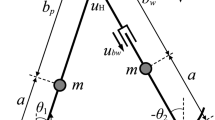Abstract
A ballistic walking gait is designed for a 3D biped with two identical two-link legs, a torso, and two identical one-link arms. In the single support phase, the biped moves due to the existence of a momentum, produced mechanically, without applying active torques in the interlink joints. This biped is controlled with impulsive torques at the instantaneous double support to obtain a cyclic gait. The impulsive torques are applied in the seven interlink joints. Then an infinity of solutions exists to find the impulsive torques. An effort cost functional of these impulsive torques is minimized to determine a unique solution. Numerical results show that for a given time period and a given length of the walking gait step, there is an optimal swinging amplitude of the arms. For this optimal motion of the arms, the cost functional is minimum.





Similar content being viewed by others
Notes
Therefore, there is a permutation operation between \(\dot{\mathbf{X}}^{a}\) and the solution of the boundary value problem to take into account the exchange of the role of both legs.
References
Ortega, J.D., Fehlman, L.A., Farley, C.T.: Effects of aging and arm swing on the metabolic cost of stability in human walking. J. Biomech. 41, 3303–3308 (2008)
Collins, S.H., Adamczyk, P.G., Kuo, A.D.: Dynamic arm swinging in human walking. Proc. R. Soc. Lond. B, Biol. Sci. 276, 3679–3688 (2009). doi:10.1098/rspb.2009.0664
Pontzer, H., Holloway, J.H., Raichlen, D.A., Lieberman, D.E.: Control and function of arm swing in human walking and running. J. Exp. Biol. 212, 523–534 (2009)
Bruijn, S.M., Meijer, O.G., van Dieën, J.H., Kingma, I., Lamoth, C.J.C.: Coordination of leg swing, thorax rotations, and pelvis rotations during gait: the organisation of total body angular momentum. Gait Posture 27, 455–462 (2008)
Umberger, B.R.: Effects of suppressing arm swing on kinematics, kinetics, and energetics of human walking. J. Biomech. 41, 2575–2580 (2008)
Hill, A.V.: The heat of shortening and the dynamic constants of muscle. Proc. R. Soc. Lond. B, Biol. Sci. 126, 136–195 (1938)
Doke, J., Kuo, A.D.: Energetic cost of producing cyclic muscle force, rather than work, to swing the human leg. J. Exp. Biol. 210, 2390–2398 (2007)
Vaughan, C.: Dynamics of Human Gait. Kiboho Publishers (1999)
Formal’skii, A.M.: Motion of anthropomorphic biped under implusive control. In: Proc. of Institute of Mechanics, Moscow State Lomonosov University: “Some Questions of Robot’s Mechanics and Biomechnics”, pp. 17–34 (1978) (In Russian)
Formal’skii, A.: Locomotion of Anthropomorphic Mechanisms. Nauka, Moscow (1982) [In Russian]
Formal’skii, A.M.: Ballistic walking design via impulsive control. J. Aerosp. Eng. 23(2), 129–138 (2010)
Mochon, S., McMahon, T.: Ballistic walking: an improved model. Math. Biosci. 52, 241–260 (1981)
McGeer, T.: Passive dynamic walking. Int. J. Robot. Res. 9(2), 62–82 (1990)
Hurmuzlu, Y., Chang, T.-H.: Rigid body collisions of a special class of planar kinematic chains. IEEE Trans. Syst. Man Cybern. 22(5), 964–971 (1992)
Channon, P.H., Hopkins, S.H., Pham, D.T.: Derivation of optimal walking motions for a bipedal walking robot. Robotica 10(3), 165–172 (1992)
Chevallereau, C., Aoustin, Y.: Optimal reference trajectories for walking and running of a biped. Robotica 19(5), 557–569 (2001)
Gill, P., Murray, W., Wright, M.: Practical Optimization. Academic Press, London (1981)
Powell, M.: Variable Metric Methods for Constrained Optimization. Lecture Notes in Mathematics, pp. 62–72. Springer, Berlin (1977)
Aoustin, Y., Formal’sky, A.M.: On optimal swinging of the biped arms. In: Proc. IEEE Int. Conf. on Intelligent Robots and Systems IROS, Nice, France, pp. 2922–2927 (2008)
Eke-Okoro, S.T., Gregoric, M., Larson, L.E.: Alterations in gait resulting from deliberate changes of arm-swing amplitude and phase. Clin. Biomech. 12(7/8), 516–521 (1997)
Acknowledgements
This work was supported by Ministry of Education and Science of Russian Federation, Project 07.524.11.4012 and CNRS via a Project of International Collaboration Scientific, PICS 3866. Cooperation agreement CNRS/Russian Academy of Sciences (EDC25146).
Author information
Authors and Affiliations
Corresponding author
Rights and permissions
About this article
Cite this article
Aoustin, Y., Formalskii, A.M. 3D walking biped: optimal swing of the arms. Multibody Syst Dyn 32, 55–66 (2014). https://doi.org/10.1007/s11044-013-9378-3
Received:
Accepted:
Published:
Issue Date:
DOI: https://doi.org/10.1007/s11044-013-9378-3




